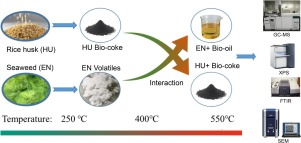当前位置:
X-MOL 学术
›
J. Anal. Appl. Pyrol.
›
论文详情
Our official English website, www.x-mol.net, welcomes your
feedback! (Note: you will need to create a separate account there.)
Bio-char and bio-oil characteristics produced from the interaction of Enteromorpha clathrate volatiles and rice husk bio-char during co-pyrolysis in a sectional pyrolysis furnace: A complementary study
Journal of Analytical and Applied Pyrolysis ( IF 5.8 ) Pub Date : 2018-10-01 , DOI: 10.1016/j.jaap.2018.08.030 Shuang Wang , Ding Jiang , Bin Cao , Lili Qian , Yamin Hu , Lu Liu , Chuan Yuan , Abd El-Fatah Abomohra , Zhixia He , Qian Wang , Bo Zhang
Journal of Analytical and Applied Pyrolysis ( IF 5.8 ) Pub Date : 2018-10-01 , DOI: 10.1016/j.jaap.2018.08.030 Shuang Wang , Ding Jiang , Bin Cao , Lili Qian , Yamin Hu , Lu Liu , Chuan Yuan , Abd El-Fatah Abomohra , Zhixia He , Qian Wang , Bo Zhang

|
Abstract The present work aimed to study the heterogenous interaction between lignocellulosic bio-char and seaweeds volatiles during co-pyrolysis process using a sectional pyrolysis reactor. Enteromorpha clathrate (EN) and rice husk (HU) were selected as representatives for seaweeds and lignocelluloses, respectively. Physical and chemical properties of the interacted bio-char were studied. In addition, the produced bio-oil was characterized by gas chromatography mass spectrometer (GC/MS). After interaction with EN volatiles, the yield of interacted solid residue (HU + bio-char) increased in comparison with that of HU bio-char, with pronounced changes in C, N and H contents, suggesting deposition of some volatiles on the bio-char surface. FTIR analysis confirmed that the interaction between volatiles and the unstable highly active spots on the bio-char led to polycondensation reactions which resulted in more aromatic compounds. In addition, XPS spectra showed that the free radicals in EN volatiles play a significant role in removal of oxygen functional groups in HU bio-char. Furthermore, pore structure analysis and SEM confirmed that some micropores (
中文翻译:

分段热解炉共热解过程中浒苔包合物挥发物与稻壳生物炭相互作用产生的生物炭和生物油特性:一项补充研究
摘要 目前的工作旨在研究使用分段热解反应器的共热解过程中木质纤维素生物炭和海藻挥发物之间的异质相互作用。浒苔 (EN) 和稻壳 (HU) 分别被选为海藻和木质纤维素的代表。研究了相互作用的生物炭的物理和化学性质。此外,生产的生物油通过气相色谱质谱仪 (GC/MS) 进行表征。与 EN 挥发物相互作用后,与 HU 生物炭相比,相互作用的固体残留物(HU + bio-char)的产量增加,C、N 和 H 含量发生显着变化,表明一些挥发物沉积在生物炭上。炭表面。FTIR 分析证实,挥发物与生物炭上不稳定的高活性点之间的相互作用导致缩聚反应,从而产生更多的芳香族化合物。此外,XPS 光谱表明,EN 挥发物中的自由基在去除 HU 生物炭中的氧官能团方面起着重要作用。此外,孔结构分析和 SEM 证实了一些微孔(
更新日期:2018-10-01
中文翻译:

分段热解炉共热解过程中浒苔包合物挥发物与稻壳生物炭相互作用产生的生物炭和生物油特性:一项补充研究
摘要 目前的工作旨在研究使用分段热解反应器的共热解过程中木质纤维素生物炭和海藻挥发物之间的异质相互作用。浒苔 (EN) 和稻壳 (HU) 分别被选为海藻和木质纤维素的代表。研究了相互作用的生物炭的物理和化学性质。此外,生产的生物油通过气相色谱质谱仪 (GC/MS) 进行表征。与 EN 挥发物相互作用后,与 HU 生物炭相比,相互作用的固体残留物(HU + bio-char)的产量增加,C、N 和 H 含量发生显着变化,表明一些挥发物沉积在生物炭上。炭表面。FTIR 分析证实,挥发物与生物炭上不稳定的高活性点之间的相互作用导致缩聚反应,从而产生更多的芳香族化合物。此外,XPS 光谱表明,EN 挥发物中的自由基在去除 HU 生物炭中的氧官能团方面起着重要作用。此外,孔结构分析和 SEM 证实了一些微孔(











































 京公网安备 11010802027423号
京公网安备 11010802027423号